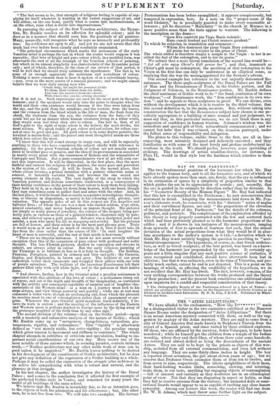HAT ON THE PARTHENON.*
The two fundamental positions of the harmonic law which Mr. Hay applies to the human body, and to all the formative arts, and of which we have already spoken more than once, are, firstly, that the eye is influenced in its estimation of spaces by a simplicity of proportion similar to that which guides the ear in its appreciation of sounds ; and, secondly, that the eye is guided in its estimate by direction rather than by distance. In his "Geometric Beauty of the Human Figure" Mr. Hay had indicated that this law is exemplified in the Parthenon ; he now demonstrates that statement in detail. Adopting the measurements laid down in Mr. Pen- rose's elaborate work, he constructs, with his " diatonic " series of angles and their curvilinear figures, not only " the proportions of the elevation of the principal front of the Parthenon," but the details of the columns, pediment, and peristyle. The completeness of the explanation afforded by this theory is very properly contrasted with the few and scattered facts which had been previously gleaned as to the harmonic proportions of the edifice ; and it is shown in ten instances of the measurements, ranging from upwards of four to upwards of fourteen feet each, that the utmost deviation of the actual proportions from what they would be if in abso- lute accordance to the author's system is 0.145,—a deviation which we think Mr. Hay is not unfairly begging the question in ascribing to "acci- dental circumstances." The hypothesis, of course, is, that Greek architec- ture, as well as Greek sculpture, of the best period, was based on a know- ledge of the harmonic law propounded by the author. It certainly ap- pears not a little singular that any such positive science of [esthetics, if once recognized and established, should have afterwards been lost in oblivion ; but that it was unknown, even in the time of Vitruvius, and pro- bably much earlier, cannot be and is not disputed. This is a point on the bearings of which, as affecting the credibility of the hypothesis, we do not recollect that Mr. Hay has dwelt. The fact, however, remains, of the very striking correspondence between the works produced and the theory of their production ; and the present book constitutes one additional claim upon inquirers for a candid and respectful consideration of that theory.
• The Orthographic Beauty of the Parthenon referred to a Law of Nature : to which are prefixed a few Observations on the Importance of lEsthetic Science as an Element in Architectural Education. By D. R. Bay, P.R.S.E. Published by Black- wood and Sons.


































 Previous page
Previous page